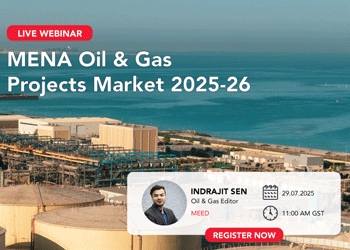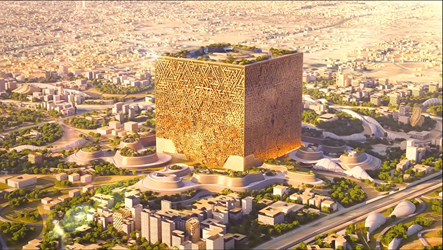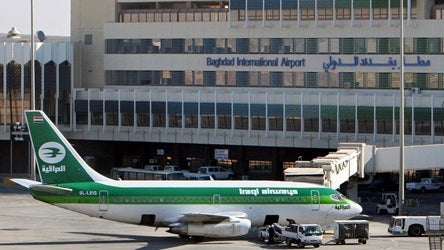Qatar breaks ground on $6bn petrochemicals project
21 February 2024
Register for MEED's guest programme
Qatar’s Emir Sheikh Tamim Bin Hamad Al Thani has laid the foundation stone for the country’s estimated $6bn Ras Laffan petrochemicals complex.
The project is being developed by a joint venture (JV) of QatarEnergy and US-based Chevron Phillips Chemical (CPChem).
QatarEnergy owns a majority 70 per cent stake in the JV. CPChem – 50:50 owned by the US’ Chevron and Phillips 66 – holds the remaining 30 per cent.
The Ras Laffan petrochemicals complex is expected to begin production in 2026. It consists of an ethane cracker with a capacity of 2.1 million tonnes a year (t/y) of ethylene. This will raise Qatar’s ethylene production potential by nearly 70 per cent.
The ethane cracker will be the largest in the Middle East and one of the largest in the world.
The complex includes two polyethylene trains with a combined output of 1.68 million t/y of high-density polyethylene (HDPE) polymer products, raising Qatar’s overall petrochemical production capacity by 82 per cent to almost 14 million t/y.
QatarEnergy and CPChem signed the final investment decision (FID) agreement last January for the Ras Laffan petrochemicals complex, an integrated olefins and polyethylene facility being built in Qatar’s Ras Laffan Industrial City.
EPC contract awards
Along with the FID deal, QatarEnergy/CPChem awarded the two main contracts for the project’s engineering, procurement and construction (EPC) works.
A JV of South Korean contractor Samsung Engineering and CTCI of Taiwan was awarded the EPC contract for the ethylene plant.
Samsung Engineering said it would be in charge of the major ethylene production facilities, with its scope of work including furnaces, ethane (C2) hydrogenation, the hydrogen purification unit and three main compressors. CTCI is responsible for the utility infrastructure, including steam/condensate collecting and boiler feed water.
The EPC contract for the polyethylene plant was awarded to Italian contractor Maire Tecnimont, which announced the value of its contract to be $1.3bn.
Maire Tecnimont is required to execute the EPC of the main polyethylene plant, which includes two polyethylene units, with a capacity of 1 million t/y and 680,000 t/y, respectively, together with the associated utilities and offsite facilities. The Italian contractor’s scope of work also covers engineering services, equipment and material supply, erection and construction activities up to mechanical completion.
US-headquartered industrial digitalisation services provider Emerson was awarded the main automation contract for the Ras Laffan petrochemicals project.
The FID agreement and EPC contract awards were signed at a ceremony in Doha on 8 January 2023. Saad Sherida Al Kaabi, Qatar’s minister of state for energy affairs and president and CEO of QatarEnergy, and Bruce Chinn, president and CEO of CPChem, signed the agreement.
Giant petrochemicals scheme
In September 2022, MEED reported on the frontrunners to win the two main EPC contracts.
Japan-headquartered JGC Corporation and South Korea’s Daelim have performed the front-end engineering and design (feed) works on the Ras Laffan petrochemicals scheme as part of contracts they were awarded in 2020 by the QatarEnergy/CPChem JV.
QatarEnergy issued the main EPC tenders for the ethane cracker and HDPE unit EPC packages in October 2021. Contractors submitted technical bids on 5 May 2022, while commercial bids were submitted by 7 August of that year.
After receiving bids, QatarEnergy/CPChem engaged in technical clarifications and commercial discussions with contractors.
In June 2022, the QatarEnergy/CPChem JV awarded a package relating to early site works on the project to Consolidated Contractors Company (CCC).
QatarEnergy-CPChem partnership
The FID agreement for the Ras Laffan petrochemicals project came less than two months after QatarEnergy and CPChem reached the FID to execute the Golden Triangle polymers plant, an $8.5bn integrated polymers facility located on the Gulf of Mexico coast in the US state of Texas.
The project is owned by Golden Triangle Polymers Company, a JV in which CPChem owns a 51 per cent stake and QatarEnergy the other 49 per cent equity interest.
Located about 180 kilometres east of Houston, Texas, the plant will include an ethylene cracker unit, which will also have a capacity of 2.1 million t/y, and two HDPE units with a combined capacity of 2 million t/y, making them the largest derivatives units of their kind in the world.
EPC work on the project has started, with an expected commissioning date in 2026. CPChem will operate the facility after start-up.
Exclusive from Meed
-
 WEBINAR: Mena Oil & Gas Projects Market 2025-26
WEBINAR: Mena Oil & Gas Projects Market 2025-2610 July 2025
-

-
 Chinese firm wins Mid Island Parkway tunnelling deal
Chinese firm wins Mid Island Parkway tunnelling deal10 July 2025
-
 Iraq tenders Baghdad airport PPP project
Iraq tenders Baghdad airport PPP project9 July 2025
-

All of this is only 1% of what MEED.com has to offer
Subscribe now and unlock all the 153,671 articles on MEED.com
- All the latest news, data, and market intelligence across MENA at your fingerprints
- First-hand updates and inside information on projects, clients and competitors that matter to you
- 20 years' archive of information, data, and news for you to access at your convenience
- Strategize to succeed and minimise risks with timely analysis of current and future market trends

Related Articles
-
 WEBINAR: Mena Oil & Gas Projects Market 2025-26
WEBINAR: Mena Oil & Gas Projects Market 2025-2610 July 2025
Date & Time: Tuesday 29 July 2025 | 11:00 AM GST
Agenda:
1. Summary of the Mena oil, gas and petrochemicals projects market
2. Summary description of the main megaprojects, including project programmes
3. Analysis of active contracts and spending to date
4. Analysis of top contracts by work already awarded
5. Long-term capital expenditure outlays and forecasts
6. Highlights of key contracts to be tendered and awarded over the next 18 months
7. Top contractors and clients
8. Breakdown of spending by segment, ie, oil, gas, petrochemicals – upstream, downstream, onshore and offshore
9. Q&A session
https://image.digitalinsightresearch.in/uploads/NewsArticle/14241705/main.gif -
 New Murabba signs up South Korean firm for design works
New Murabba signs up South Korean firm for design works10 July 2025
Register for MEED’s 14-day trial access
Saudi Arabia’s New Murabba Development Company (NMDC) has signed a memorandum of understanding (MoU) with South Korea’s Heerim Architects & Planners to explore further design works on assets at the 14 square-kilometre New Murabba downtown project.
According to an official statement: “Heerim Architects & Planners will explore distinctive architectural plans that complement the development’s masterplan, with special focus on anchor assets, linear parks and smart city features.”
New Murabba CEO Michael Dyke signed the agreement last week during the company’s Investment and Partnership Forum in Seoul.
At the event, NMDC also signed an MoU with South Korea’s Naver Cloud Corporation to explore technological solutions for delivering the New Murabba downtown project.
According to an official statement: “The three-year agreement covers exploring innovative technology and automation to support the delivery of New Murabba, including robotics, autonomous vehicles, a smart city platform and digital solutions for monitoring construction progress.”
NMDC is in Seoul to examine technological offerings, assess financing options and showcase the investment opportunities available for the New Murabba downtown development.
The statement added that the excavation works for The Mukaab, the centrepiece of the overall development, have now been completed.
The Mukaab is a Najdi-inspired landmark that will be one of the largest buildings in the world. It will be 400 metres high, 400 metres wide and 400 metres long. Internally, it will have a tower on top of a spiral base and a structure featuring 2 million square metres (sq m) of floor space designated for hospitality. It will feature commercial spaces, cultural and tourist attractions, residential and hotel units, and recreational facilities.
Downtown destination
The New Murabba destination will have a total floor area of more than 25 million sq m and feature more than 104,000 residential units, 9,000 hotel rooms and over 980,000 sq m of retail space.
The scheme will include 1.4 million sq m of office space, 620,000 sq m of leisure facilities and 1.8 million sq m of space dedicated to community facilities.
The project will be developed around the concept of sustainability and will include green spaces and walking and cycling paths to promote active lifestyles and community activities.
The living, working and entertainment facilities will be developed within a 15-minute walking radius. The area will use an internal transport system and will be about a 20-minute drive from the airport.
The downtown area will feature a museum, a technology and design university, an immersive, multipurpose theatre, and more than 80 entertainment and cultural venues.
 READ THE JULY 2025 MEED BUSINESS REVIEW – click here to view PDF
READ THE JULY 2025 MEED BUSINESS REVIEW – click here to view PDFUAE and Turkiye expand business links; Renewed hope lies on the horizon for trouble-beset Levant region; Gulf real estate momentum continues even as concerns emerge
Distributed to senior decision-makers in the region and around the world, the July 2025 edition of MEED Business Review includes:
> AGENDA: UAE-Turkiye trade gains momentum> INTERVIEW 1: Building on UAE-Turkiye trade> INTERVIEW 2: Turkiye's Kalyon goes global> INTERVIEW 3: Strengthening UAE-Turkiye financial links> INTERVIEW 4: Turkish Airlines plans further growth> CURRENT AFFAIRS: Middle East tensions could reduce gas investments> GCC REAL ESTATE: Gulf real estate faces a more nuanced reality> PROJECTS MARKET: GCC projects market collapses> INTERVIEW 5: Hassan Allam eyes role in Saudi Arabia’s transformation> INTERVIEW 6: Aseer region seeks new investments for Saudi Arabia> LEADERSHIP: Nuclear power makes a global comeback> LEVANT MARKET FOCUS: Levant states wrestle regional pressures> GULF PROJECTS INDEX: Gulf projects index continues climb> CONTRACT AWARDS: Mena contract award activity remains subdued> ECONOMIC DATA: Data drives regional projects> OPINION: A farcical tragedy that no one can endTo see previous issues of MEED Business Review, please click herehttps://image.digitalinsightresearch.in/uploads/NewsArticle/14239016/main.jpg -
 Chinese firm wins Mid Island Parkway tunnelling deal
Chinese firm wins Mid Island Parkway tunnelling deal10 July 2025

Register for MEED’s 14-day trial access
Beijing-headquartered China Railway Tunnel Engineering Group has won a $60m subcontract for the tunnelling works on package 1B of the Mid Island Parkway project in Abu Dhabi.
Package 1B entails the construction of a cut-and-cover tunnel to cross the Khor Laffan Channel, which is the area between the Saadiyat and Um-Yifeenah islands.
The tunnel, which will be between 900 metres and 1 kilometre (km) long, is being constructed on a design-and-build basis and will tie in to packages 1A and 1C.
The project is being jointly constructed by a joint venture of local firm Yas Projects (Alpha Dhabi Holding) and Beijing-based China Railway International Group.
In June last year, MEED exclusively reported that Abu Dhabi's Department of Municipality & Transport had awarded contracts for three packages for phase one of the Mid Island Parkway Project (MIPP), as part of the Plan Capital urban evolution programme.
Phase one will start at the existing Saadiyat Interchange, which will connect the E12 road to the MIPP, and will end with the recently constructed Um-Yifeenah Highway.
It comprises a dual main road with a total length of 8km, including four traffic lanes in each direction, two interchanges, a tunnel and associated infrastructure works.
MIPP phase one is further divided into packages 1A, 1B and 1C, which were awarded separately.
The project ownership has been transferred from Aldar Properties to Abu Dhaibi's Department of Municipalities & Transport.
Previously, it was transferred from Abu Dhabi General Services Company (Musanada) to Aldar Properties, and the project was included in the Abu Dhabi Investment Office's public-private partnership project pipeline.
 READ THE JULY 2025 MEED BUSINESS REVIEW – click here to view PDF
READ THE JULY 2025 MEED BUSINESS REVIEW – click here to view PDFUAE and Turkiye expand business links; Renewed hope lies on the horizon for trouble-beset Levant region; Gulf real estate momentum continues even as concerns emerge
Distributed to senior decision-makers in the region and around the world, the July 2025 edition of MEED Business Review includes:
> AGENDA: UAE-Turkiye trade gains momentum> INTERVIEW 1: Building on UAE-Turkiye trade> INTERVIEW 2: Turkiye's Kalyon goes global> INTERVIEW 3: Strengthening UAE-Turkiye financial links> INTERVIEW 4: Turkish Airlines plans further growth> CURRENT AFFAIRS: Middle East tensions could reduce gas investments> GCC REAL ESTATE: Gulf real estate faces a more nuanced reality> PROJECTS MARKET: GCC projects market collapses> INTERVIEW 5: Hassan Allam eyes role in Saudi Arabia’s transformation> INTERVIEW 6: Aseer region seeks new investments for Saudi Arabia> LEADERSHIP: Nuclear power makes a global comeback> LEVANT MARKET FOCUS: Levant states wrestle regional pressures> GULF PROJECTS INDEX: Gulf projects index continues climb> CONTRACT AWARDS: Mena contract award activity remains subdued> ECONOMIC DATA: Data drives regional projects> OPINION: A farcical tragedy that no one can endTo see previous issues of MEED Business Review, please click herehttps://image.digitalinsightresearch.in/uploads/NewsArticle/14238039/main3047.gif -
 Iraq tenders Baghdad airport PPP project
Iraq tenders Baghdad airport PPP project9 July 2025
Register for MEED’s 14-day trial access
Iraq’s Ministry of Transport and the General Company for Airport & Air Navigation Services have released a tender inviting firms to bid for a contract to develop Baghdad International airport on a public-private partnership (PPP) basis.
The notice was issued in July, and the submission deadline is in September.
According to an official statement posted on its website, Iraq’s Ministry of Transport said that 10 out of 14 international consortiums that expressed interest in the project earlier this year have been prequalified to compete for the tender.
The scope of the estimated $400m-$600m project involves rehabilitating, expanding, financing, operating and maintaining the airport. It is the first airport PPP project to be launched in Iraq.
The initial capacity of the airport is expected to be around 9 million passengers, which will be gradually increased to 15 million passengers.
The International Finance Corporation (IFC), a member of the World Bank Group, is the project’s lead transaction adviser.
Iraq is already developing the Baghdad and Najaf-Karbala metro projects using a similar PPP model.
Earlier this month, MEED reported that Iraq intends to retender the contract to develop and operate the Baghdad Metro project, following the award of the estimated $2.5bn contract last year.
According to local media reports, Nasser Al-Assadi, adviser to Prime Minister Mohammed Sudani, stated that the previous developers had overestimated the project budget; therefore, the government will relaunch the entire process to implement the project.
https://image.digitalinsightresearch.in/uploads/NewsArticle/14229008/main.jpg -
 Contractors prepare revised bids for Roshn stadium
Contractors prepare revised bids for Roshn stadium9 July 2025

Register for MEED’s 14-day trial access
Saudi gigaproject developer Roshn has invited firms to submit revised commercial proposals by 24 July for a contract to build a new stadium adjacent to the National Guard facilities to the southwest of Riyadh.
Known as the National Guard Stadium, it will be delivered on an early contractor involvement (ECI) basis. It will cover an area of over 450,000 square metres and be able to accommodate 46,000 spectators.
The scope of work also covers the construction of auxiliary facilities, including training academy offices and two hotels, as well as retail and food and beverage outlets.
The firms had initially submitted bids on 8 April for the contract.
The stadium is scheduled to host 32 Fifa World Cup tournament games in 2034.
In August last year, MEED reported that Saudi Arabia plans to build 11 new stadiums as part of its bid to host the 2034 Fifa World Cup.
Eight stadiums will be located in Riyadh, four in Jeddah and one each in Al-Khobar, Abha and Neom.
The proposal outlines an additional 10 cities that will host training bases. These are Al-Baha, Jazan, Taif, Medina, Al-Ula, Umluj, Tabuk, Hail, Al-Ahsa and Buraidah.
The bid proposes 134 training sites across the kingdom, including 61 existing facilities and 73 new training venues.
The kingdom was officially selected to host the 2034 Fifa World Cup through an online convention of Fifa member associations at the Fifa congress on 11 December 2024.
 https://image.digitalinsightresearch.in/uploads/NewsArticle/14228507/main.jpg
https://image.digitalinsightresearch.in/uploads/NewsArticle/14228507/main.jpg

